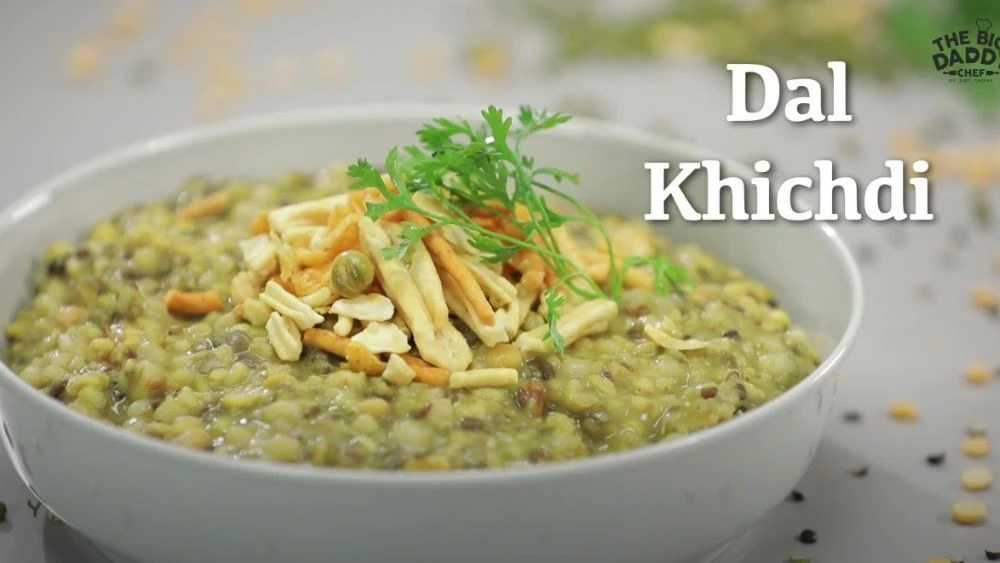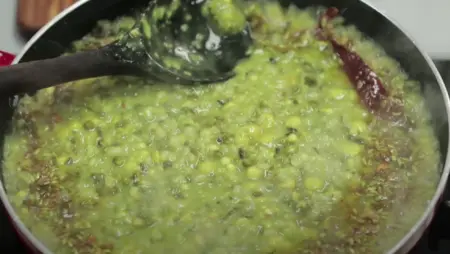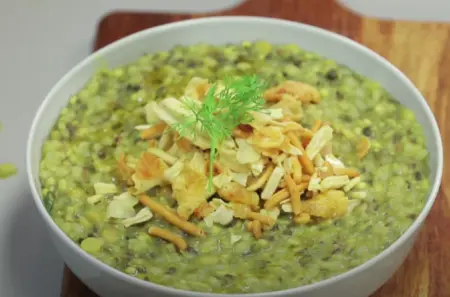
Dal Khichdi Recipe

20min

2-3 people

10 mins
Introduction
Growing up, I vividly remember the aroma of khichdi wafting through our home on lazy Sunday afternoons. It was a dish that transcended mere sustenance; it was comfort in a bowl, a culinary hug that warmed both body and soul. The memories of those cozy family meals linger fondly in my mind, inspiring my lifelong love affair with this quintessential Indian comfort food.
Khichdi holds a special place in my heart, not just for its nourishing simplicity but also for its versatility. It's a canvas upon which countless variations can be painted, each one as unique as the chef who prepares it. From the traditional rice and lentil combination to innovative twists like the multigrain rendition we're about to delve into, khichdi never fails to surprise and delight.
Recipe of Dal Khichdi
Portions serving: 5-6 servings
Preparation time: 10 minutes
Cooking time: 30 minutes
Calories: 214 calories per serving
Ingredients:
-
For Boiling:
- Water
- 1/4 cup Millets, soaked
- 1/4 cup Jowar, soaked
- 1/4 cup Barley, soaked
- 1/4 cup Chana Dal, soaked
- 1/4 cup Green Moong, soaked
- 1/4 cup Black Urad, soaked
- 1/4 cup Moong Dal, soaked
- Salt to taste
- 1 tsp Turmeric Powder
-
For Tadka:
- 1 tbsp Ghee
- 1 tsp Cumin Seeds
- 1 Green Chilli, chopped
- 1 tsp Garlic, chopped
- 1 tsp Ginger, chopped
- 1 Dry Red Chilli
- 1/2 tsp Hing (Asafoetida)
- 1 tsp Fennel Seeds
- 1/4 cup Water
- 1 tbsp Coriander Powder
- Fresh Coriander for garnish
Instructions:
1. Preparation:
Start by soaking the millets, jowar, barley, chana dal, green moong, black urad, and moong dal in water. Soaking the pulses beforehand helps in reducing the cooking time and improves their digestibility.
2. Boiling the Pulses:
In a pan, add water and bring it to a boil. Drain the soaked pulses and add them to the boiling water. Also, add salt and turmeric powder to the pan, mixing well. Cover the pan with a lid and let the pulses cook until they become mushy. This may take about 18-20 minutes, depending on the pulses' size and variety.
3. Checking Consistency:
Once the pulses are cooked, remove the lid and check the consistency. If needed, add more water to achieve the desired consistency. Bring the mixture to a boil again, allowing all the flavors to meld.
4. Preparing the Tadka:
In a separate pan, heat ghee over medium heat. Add cumin seeds and let them splutter, releasing their nutty aroma. Then, add chopped green chili, garlic, and ginger, sautéing them for a while to infuse the ghee with their pungent and spicy flavors.
5. Adding Flavor:
To enhance the tadka, add a dry red chili, hing (asafoetida), and fennel seeds. These ingredients impart a unique and aromatic taste to the dish.
6. Combining Tadka and Cooked Pulses:
Pour water into the pan with the tadka, creating a flavorful mixture. Now, add the cooked pulses to the pan and let them cook together for 2-3 minutes, allowing the pulses to absorb the delightful tadka.

7. Adding Coriander Powder:
Sprinkle coriander powder over the mixture, adding a burst of earthy and citrusy notes. Check the seasoning and adjust salt if necessary, ensuring a well-balanced taste.
8. Garnish and Serve:
Finally, garnish the dish with fresh coriander leaves, adding a touch of freshness and brightness to the presentation. Serve the wholesome and flavorful mixed dal khichdi with a side of yogurt, pickle, or papad for a complete and satisfying meal.

About the Recipe
The journey to crafting the perfect multigrain khichdi is as much about tradition as it is about innovation. Drawing inspiration from the rich tapestry of Indian culinary heritage, this recipe pays homage to the timeless flavors of dal khichdi while embracing the wholesome goodness of millets and jowar. By blending ancient grains with contemporary cooking techniques, we create a dish that is both comforting and nourishing, a true celebration of India's culinary diversity.
Cooking Tips
1. Choose Quality Ingredients: Opt for high-quality lentils, millets, and spices to enhance the flavor profile of your khichdi.
2. Soak Grains and Lentils: Soaking grains and lentils overnight helps improve their digestibility and reduces cooking time.
3. Control Consistency: Adjust the amount of water to achieve your desired khichdi consistency, whether you prefer it soupy or thick.
4. Experiment with Tempering: Get creative with your tempering ingredients to add depth and complexity to your khichdi.
5. Garnish Generously: Fresh herbs, fried onions, and a drizzle of ghee elevate the presentation and flavor of your khichdi.
Pairing Guide
Beverage: Pair your multigrain khichdi with a refreshing glass of buttermilk or a soothing cup of masala chai.
Accompaniments: Serve with a side of tangy pickle, crunchy papad, or cooling raita for a balanced meal.
Dessert: Conclude your khichdi feast with a traditional Indian sweet like gulab jamun or kheer for a touch of indulgence.
Frequently Asked Questions about Multigrain Khichdi
1. Is multigrain khichdi healthier than traditional rice-based khichdi? Yes, multigrain khichdi offers a wider array of nutrients due to the inclusion of various grains like millets and jowar.
2. Can I customize the grains in multigrain khichdi? Absolutely! Feel free to experiment with different combinations of grains to suit your taste preferences and dietary requirements.
3. How can I make multigrain khichdi more flavorful? Enhance the flavor of your khichdi by using fragrant spices, fresh herbs, and a generous amount of ghee in the tempering.
4. Is multigrain khichdi suitable for a gluten-free diet? Yes, as long as you ensure that the grains and lentils used are certified gluten-free, multigrain khichdi can be enjoyed as part of a gluten-free diet.
5. Can I make multigrain khichdi in a pressure cooker? Certainly! Cooking multigrain khichdi in a pressure cooker can help reduce cooking time while retaining the nutrients and flavors of the ingredients.
6. Is multigrain khichdi suitable for weight loss diets? Multigrain khichdi can be a nutritious addition to weight loss diets, thanks to its high fiber content and balanced macronutrient profile.
7. How long can I store multigrain khichdi in the refrigerator? Multigrain khichdi can be stored in an airtight container in the refrigerator for up to 3-4 days. Reheat gently before serving.
8. Can I make multigrain khichdi without soaking the grains and lentils overnight? While soaking grains and lentils overnight is recommended for better digestion and texture, you can still make multigrain khichdi without soaking, although the cooking time may be slightly longer.
9. Is multigrain khichdi suitable for diabetic individuals? Yes, multigrain khichdi can be included in a diabetic-friendly diet as part of a balanced meal plan, but it's essential to monitor portion sizes and overall carbohydrate intake.
10. Can I add vegetables to multigrain khichdi for extra nutrition? Absolutely! Adding vegetables like carrots, peas, and spinach not only enhances the nutritional value of multigrain khichdi but also adds color and flavor to the dish.
